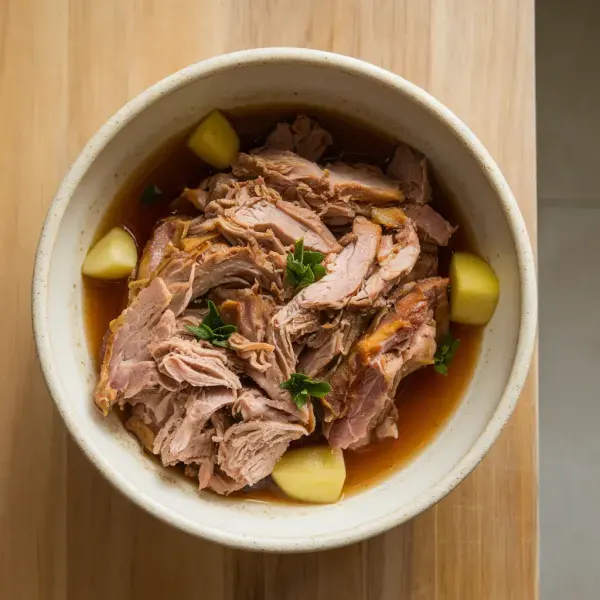
 560 minutes
560 minutesA comforting and delicious meal that combines the savory richness of pork with the sweet and tangy notes of apple cider and apple butter, perfect for any occasion.


Boneless Pork Butt Roast, trimmed
0 lb
tablespoons
Brown Sugar, packed
tablespoons
teaspoons
cups
Apple Butter, divided
cups
tablespoons
Onion, halved through root end
each
Garlic Clove, smashed and peeled
each
sprigs
tablespoons
Chives, minced
cups
1. Pat and Season Pork
Pat the pork dry with paper towels. Generously sprinkle the pork all over with the kosher salt, brown sugar, and black pepper.
2. Prepare Slow Cooker Mixture
In your slow cooker, whisk together the apple cider, ½ cup of apple butter, and the all-purpose flour until smooth.
3. Add Aromatics
Add the halved onion, smashed garlic cloves, and fresh thyme sprigs to the slow cooker.
4. Cook Pork
Place the seasoned pork, fat side down, into the slow cooker. Cover and cook on high for 6-7 hours or on low for 8-9 hours, until the pork is fork-tender.
5. Rest Pork
Transfer the cooked pork to a carving board with the fat side up and tent it with aluminum foil. Let it rest for about 20 minutes.
6. Prepare Sauce
Use a wide spoon to skim the fat from the surface of the sauce in the slow cooker. Discard the onion and thyme sprigs. Stir in the cider vinegar and the remaining ½ cup of apple butter. Season with salt and pepper to taste.
7. Serve Pork
Slice the pork crosswise into ½ inch thick pieces and arrange them on a serving platter. Pour about 1 cup of the sauce over the sliced pork and sprinkle with the minced chives. Serve the pork with the remaining sauce.
Mix in a bit of maple syrup with the apple cider glaze for a deeper sweetness and autumnal flavor.
Add a splash of balsamic vinegar to the glaze for a more complex acidity and a hint of umami.
Substitute non-alcoholic apple cider with a dry hard cider to introduce a subtle boozy note and more complex flavor.
Brush the roast with a mixture of Dijon mustard and apple cider glaze for a tangy kick.
Fresh minced ginger can add a spicy and zesty note that complements both the pork and the apple flavors.
Use a meat thermometer to ensure the pork is cooked to perfection. The USDA recommends cooking pork to an internal temperature of 145°F (63°C).
Allow the pork roast to rest for at least 10-15 minutes before slicing. This lets the juices redistribute, ensuring moist and tender slices.
Use high-quality, fresh apple cider for the glaze. Reduce it on the stovetop to concentrate the flavors before adding any sweeteners or spices.
Sear the pork on all sides in a hot skillet with a bit of oil. This creates a flavorful crust and helps to lock in the juices.
Brush the glaze onto the pork during the last 15-20 minutes of roasting to prevent it from burning. Apply multiple thin layers.




Comments (0)